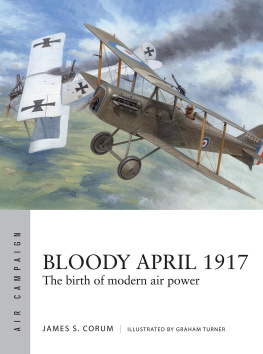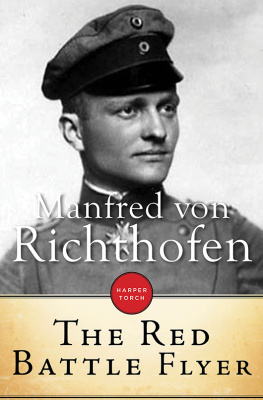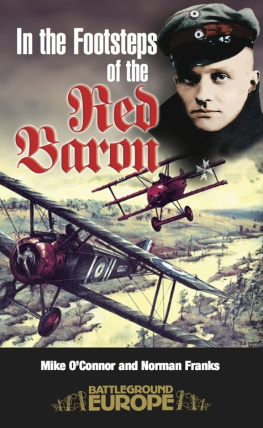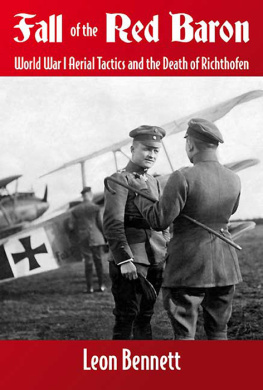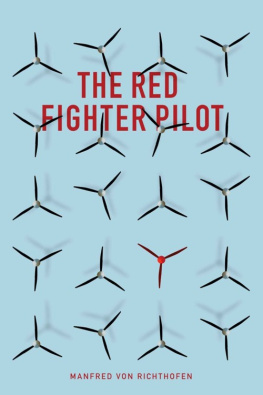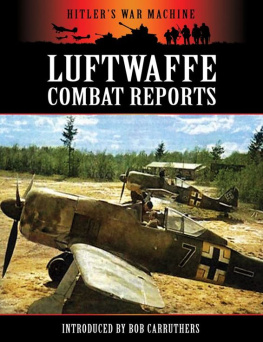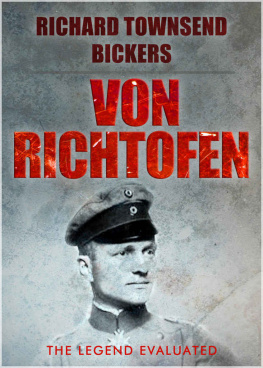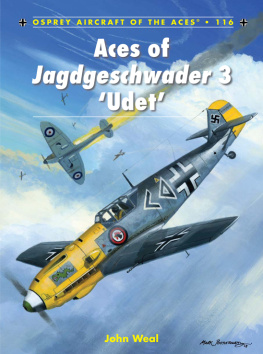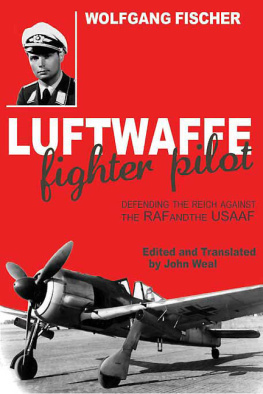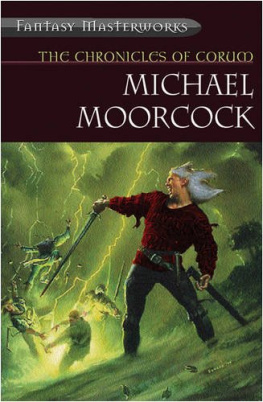Wolfram von Richthofen
MODERN WAR STUDIES
Theodore A. Wilson
General Editor
Raymond Callahan
J. Garry Clifford
Jacob W. Kipp
Jay Luvaas
Allan R. Millett
Carol Reardon
Dennis Showalter
David R. Stone
Series Editors
Wolfram von Richthofen
Master of the German Air War
James S. Corum

UNIVERSITY PRESS OF KANSAS
Except where otherwise specified, all photographs are courtesy of the von Richthofen family.
2008 by the University Press of Kansas
All rights reserved
Published by the University Press of Kansas (Lawrence, Kansas 66045), which was organized by the Kansas Board of Regents and is operated and funded by Emporia State University, Fort Hays State University, Kansas State University, Pittsburg State University, the University of Kansas, and Wichita State University
Library of Congress Cataloging-in-Publication Data
Corum, James S.
Wolfram von Richthofen : master of the German air war / James S. Corum.
p.cm. -- (Modern war studies)
Includes bibliographical references and index.
ISBN 978-0-7006-1598-8 (cloth : alk. paper)
ISBN 978-0-7006-2823-0 (ebook)
1. Richthofen, Wolfram von, 18951945. 2. MarshalsGermanyBiography. 3. Germany. LuftwaffeBiography. 4. World War, 19391945Aerial operations. I. Title.
DD247.R474C67 2008
940.544943092--dc22
[B]2008015523
British Library Cataloguing-in-Publication Data is available.
Printed in the United States of America
10 9 8 7 6 5 4 3 2 1
The paper used in the print publication meets the minimum requirements of the American National Standard for Permanence of Paper for Printed Library Materials Z39.48-1992.
CONTENTS
ACKNOWLEDGMENTS
This book would not be possible without the wonderful support I received from the von Richthofen family, most especially the son of the field marshal, Gtz Freiherr von Richthofen. The assistance I have received over the several years of research and writing has been invaluable. The von Richthofen family allowed me complete access to photographs, letters, and family papers. Freiherr von Richthofen spent many hours providing me with recollections and bits of information on his father and the von Richthofen family. No historian could have a more helpful source.
Chapter 1
Introduction
Baron Richthofen was certainly the most outstanding air force leader we had in World War II.
Field Marshal Erich von Manstein
On hearing the name von Richthofen probably ninety-nine of a hundred people will immediately think of World War Is most renowned fighter aceRittmeister Baron Manfred von Richthofen. Dozens of books and hundreds of articles have been written about this knight of the air, who managed to shoot down eighty of his opponents. In comparison, Manfreds cousin Wolfram von Richthofen, who was also a baron and also a fighter pilot in World War I, is relatively unknown. It is one of the ironies of history that the lesser-known von Richthofen had, by far, the greater impact on twentieth-century history. The cousin of the Red Knight went from service in the Imperial Air Corps to become one of the central figures in developing a resurgent Luftwaffe in the 1930s, successfully leading the Condor Legion in the Spanish Civil War. In campaign after campaign in World War II he won fame as a brilliant and successful air commander. When Wolfram von Richthofens career was ended by illness in late 1944, he was one of only five Luftwaffe officers to have reached the rank of field marshal.
As a field marshal and senior air commander Wolfram von Richthofen deserves a proper biography. It is perhaps in the nature of airpower history, which tends to overplay the importance of technology and underplay the human element in warfare, to ignore the role of important air force commanders. If one looks at the military history section of any major library, or in any bibliography of airpower history, one will see that airpower history centers on airplanes. After airplanes come books about fighter aces. In airpower bibliographies one will find more than a hundred books about Rittmeister Manfred von Richthofen, as well as numerous books about British, American, and German fighter aces of World War II. When one thinks of literature about the Luftwaffe, what comes to mind are books about great fighter pilots such as Werner Mlders, Adolf Galland, Johannes Steinhoff, and the Stuka ace Hans-Ulrich Rudel. At the other end of the scale there are books about Hermann Goering, commander in chief of the Luftwaffe, and a biography of Erhard Milch, Goerings deputy and a central figure in the Luftwaffes administration. Although Kesselring was an important air commander in the early years of World War II, he is of interest to military historians primarily for his role as a commander of ground forces in the Italian campaignnot for leading an air fleet in France or the Soviet Union. In fact, the lesser-known Wolfram von Richthofen was the air commander on the Italian front.
Thus there is very little written about senior Luftwaffe commanders. Compare this with the way the German army has been studiedthe contrast is striking. The German armys top field commanders in World War II, including Erich von Manstein, Heinz Guderian, Gerd von Rundstedt, Erwin Rommel, and Walther Model, have all been the subjects of full-length biographies. Other than
Thus the popular picture of the Luftwaffe at war consists mostly of books about equipment and the fighter aces. These are indeed important subjects, but they do not tell the reader much about the operational and strategic levels of war and leave readers with a shallow and blurred picture of the Luftwaffes great campaigns. It is largely to correct this imbalance that I have written this biography of Field Marshal Wolfram von Richthofen. Other senior commanders of the Luftwaffe also deserve detailed biographical treatment, but von Richthofen stands out for several reasons.
As a trained engineer on the army and Luftwaffe general staff in the 1920s and 1930s, von Richthofen played a key role in the buildup of German airpower and in the creation of the Luftwaffe. In the late 1920s he wrote a study of German aircraft production that would form the basis for the Luftwaffes first rearmament plans. As section chief in the Technical Office in the early 1930s he developed the airplanes that the Luftwaffe would employ so effectively in the first years of World War II. In his first experience as a senior combat commander, as Condor Legion commander and chief of staff in Spain, he earned a reputation for brilliance and ruthlessness. There he developed and refined the air/ground tactics that gave the Germans a major advantage over their opponents in the first half of World War II.
As an air corps and air fleet commander von Richthofen played a key role in several decisive actions of World War II. As commander of an air division in Poland in 1939 he demonstrated to the world what massed armor supported by massed airpower could doand the results were revolutionary. In May 1940 von Richthofens VIIIth Air Corps guarded the flanks of General Ewald von Kleists panzer group and enabled it to drive through France from Sedan to the English Channel. This action separated the Allied armies and won the campaign in a single decisive strokeand von Richthofen was a key author and player in that strategy. He was also a major player in several other major German victories. In Greece in 1941 his Stukas quickly broke Greek and British resistance. A few weeks later his air support enabled the German paratroop forces to take Crete from the British after a bloody battle. His air corps helped the German armys panzer forces to destroy several Soviet armies and to reach the gates of Moscow and Leningrad in late 1941. There is no doubt that the superb support provided by von Richthofen was a key factor in destroying huge Soviet forces in the first months of the war in the East. As air corps commander, and then air fleet commander, in southern Russia he partnered with the German armys master of operational warfare, Field Marshal Erich von Manstein, to inflict several sharp defeats on the Soviets. Then came the disaster at Stalingrad in late 1942, which destroyed the German Sixth Army and turned the tide of the war in the East. It was a bitter defeat for Manstein and von Richthofen. Yet the two great German field marshals recovered in time to hold the line in Russia after the Stalingrad debacle. Finally, from mid-1943 to late 1944, von Richthofen commanded the Luftwaffe in Italy in a well-fought, but ultimately futile, attempt to stop the Allied landings and subsequent advance up the Italian peninsula. A man with this kind of rsum deserves a thorough biography.
Next page

